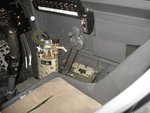ellis995
Staff Sergeant
Hi guy's
I have looked for the right "GREY" colour for the cockpit of the Bf109E.
some sites on the internet say RLM02 which looks to light and some pics look like tank grey, as the latter is what i was going to use.
Your help and views are needed
I have looked for the right "GREY" colour for the cockpit of the Bf109E.
some sites on the internet say RLM02 which looks to light and some pics look like tank grey, as the latter is what i was going to use.
Your help and views are needed

